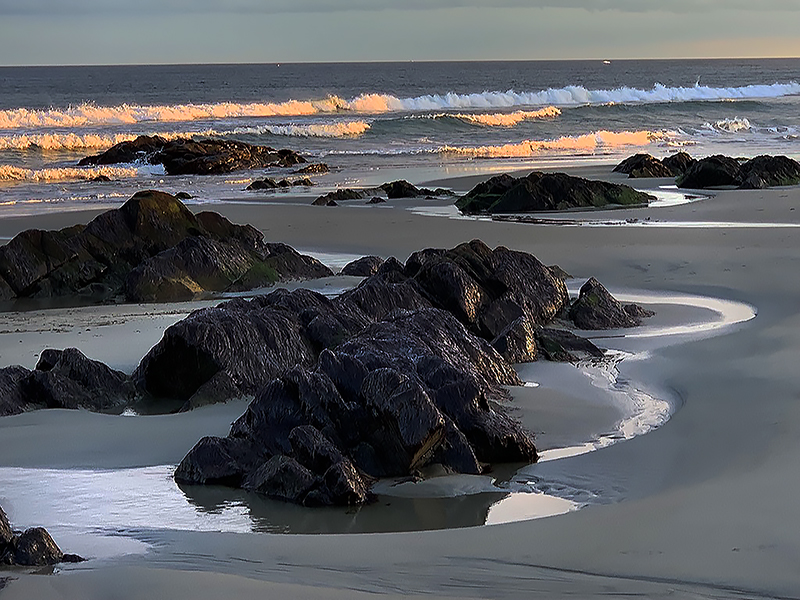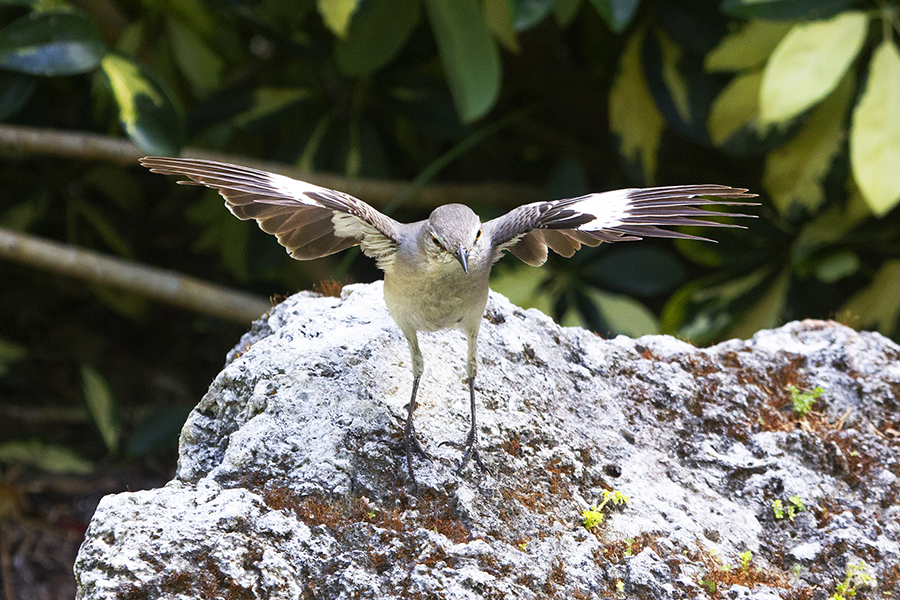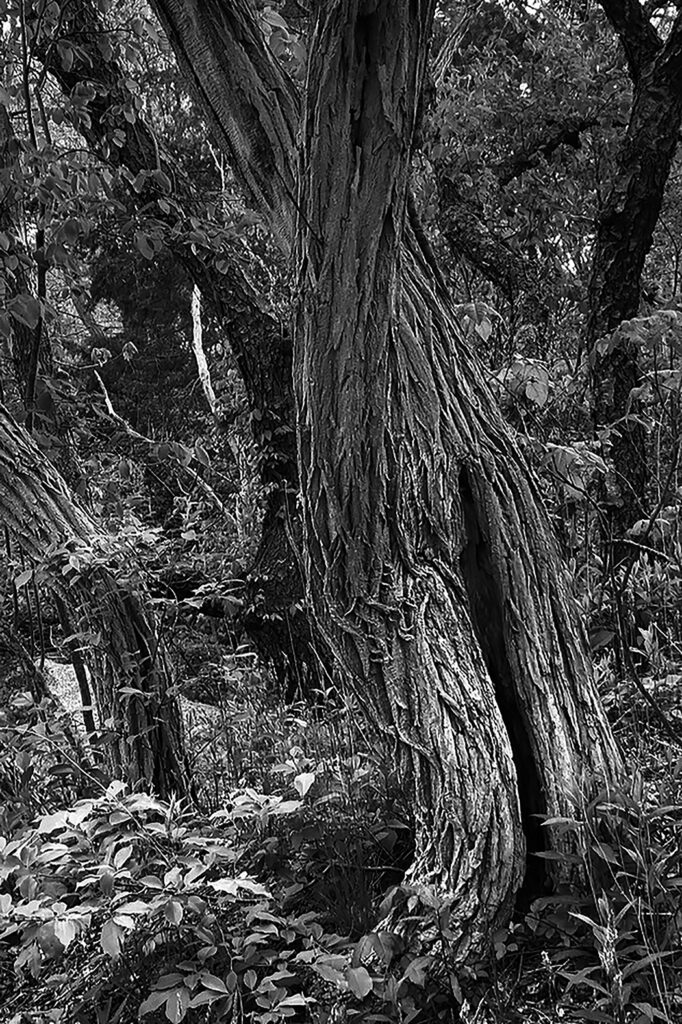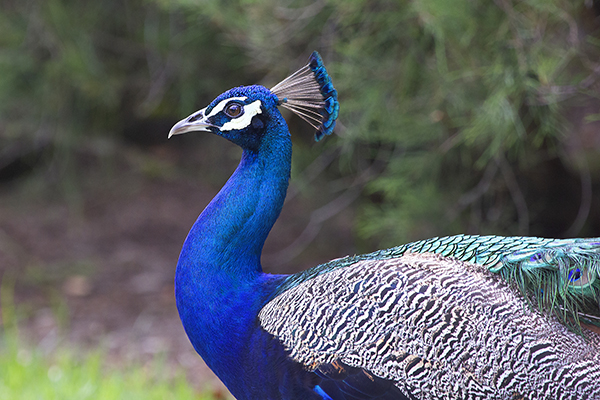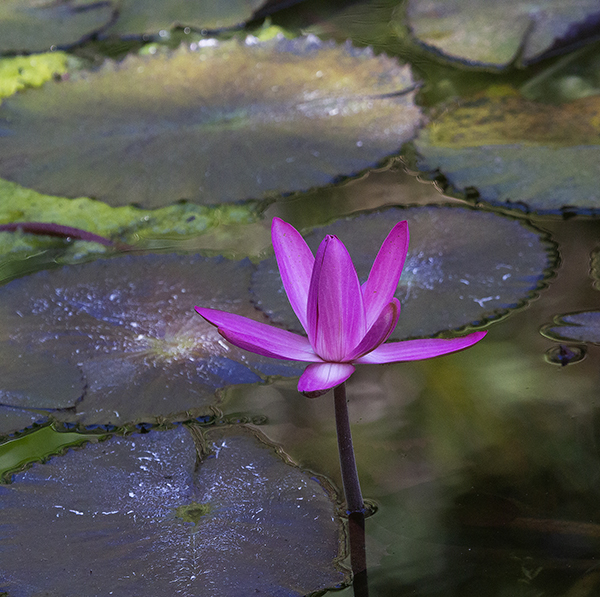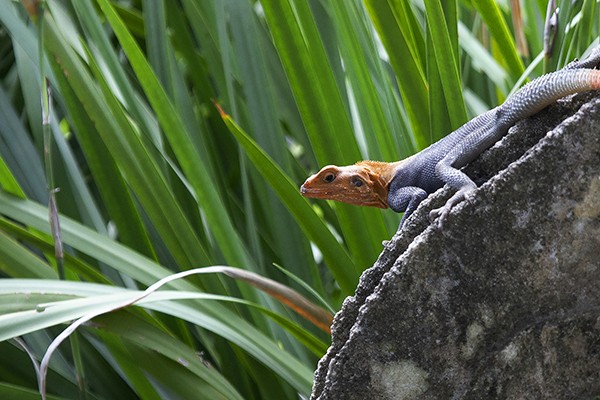I keep coming back to Cape Hedge in Rockport, MA. It inspires me. It delights and centers me. Here (Figure 1) is an image that I took in April at sunset and low tide: of the beach, the sunlit waves, the algae covered rocks, and the swirls of tidal water. I’ll let the image speak for itself, except to say that it could have been taken anywhere during the last billion years! So anxious to return!
Angry Mockingbird
One night, when I was in Key Biscayne, I heard a beautiful bird call and looked about to see what it was. My explorations were greeted by the very angry and aggressive mocking bird (Mimus polyglottos) of Figure 1. The species name polyglottos really says it all. This bird imitates other bird calls. And the term mocking may already indicate a bit of attitude. Although this one was clearly protecting its nest.
Whenever I see or hear a mockingbird, I am reminded of a school play, which we did in elementary school, about Abraham Lincoln. “Listen to the Mocking Bird” (1855). The song was a popular American song that we were told was one of Abraham Lincoln’s favorites. Its lyrics were composed by Septimus Winner under the pseudonym “Alice Hawthorne”, and its music was by Richard Milburn. Funny the way that you remember odd things.
I believe that I played Andrew Johnson and I had only one line, which I delivered with great force and energy, “No comment!” One of my classmates had a smaller part. He played Lincoln’s statue and he unfortunately passed out during the performance. Oh the indignities of youth!
Canon T2i with EF 100-400mm F/4.5-5.6 L IS USM lens at at 210 mm, ISO 1600, 1/4o0th sec at f/7.1 with no exposure compensation.
Shagbark Hickory
Another point that I learned from Ansel Adams is that a photograph of a single tree, especially in context, could be as beautiful and dramatic as a wide vista of mountains. It is a form of intimate landscape. Figure 1 is my attempt at such an image. And this time – no toning! Sometimes just black and white tells the whole story. Here the story is meant to be the a combination of the texture and the shape. You can see the failing of the small camera format in the not quite there sharpness. But I loved the scene and I loved the subject. Loving a tree? Somewhere in all of this is the recurrent meme of the sixties and seventies, Tolkein’s legend of the Ents.
And this points to another technological marvel. The photograph was not taken with my Canon T2i but with my iPhone.
Mission accomplished
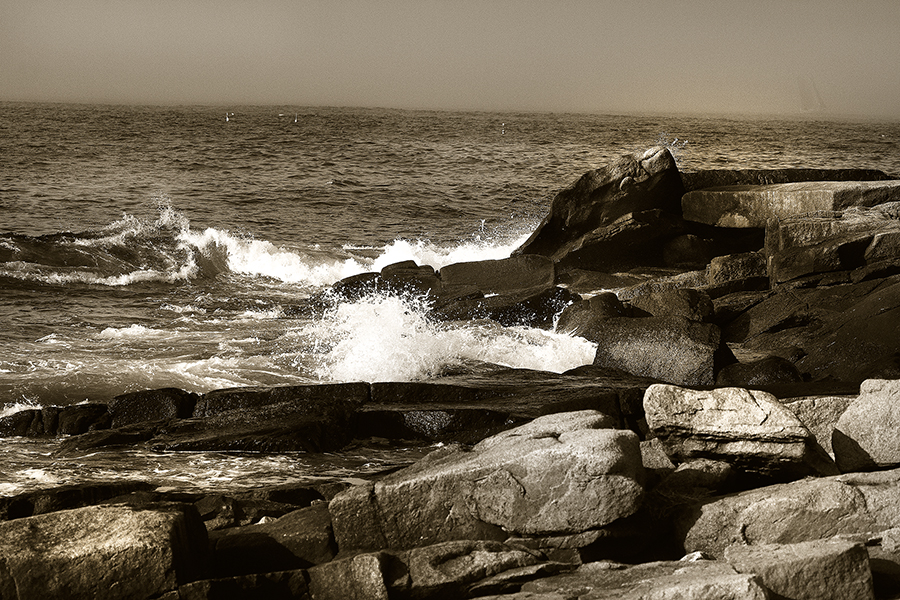
I was standing near sunset this past Saturday at Halibut Point State Park in Gloucester, MA photographing the pounding surf against the beach, and the scene struck me as a kind of “mission accomplished moment.” When I was in high school and college we seemed to worship at Ansel Adams’ feet, wishing that we too could take glorious photographs using the his “zone system.” We didn’t take many family and friends photographs back then. Our goal was chocolatey black and whites, with a nice topping of toxic selenium tone. Today I regret the lack of family and friends images from back then, despite having drawerfuls of photographs, which my wife took with automatic camera taken photographs often of my family growing-up. These out-of-focus muddy colored images were usually ordered in triplicate. But the mediocritization of popular photography was a a separate issue back then. For me the goal was always laser-sharp negatives with my glorious Leica M3 followed by a trip into my chilly and somewhat damp basement darkroom to attempt, but ever to fail, to achieve the master’s talent. I even bought a book on The Zone System for 35 mm Photographers.
There were a lot of technical issues back then – and of course the issue of vision and talent. The beauty of today is that the combination of technology and AI have enabled us to achieve it, at least technically. I emphasize the importance of 14 to 16 bit dynamic range that enables us to tweak the near perfect exposure achieved with modern AI algorithms. I set aside here the question whether true AI can be algorithmic. They are antonymic terms. But, as Ansel taught us, the goal in a photograph is the 7 to 8 bits per color plane of the final photographic print. We can pluck the needed dynamic range out of the dizzying 14 to 16 bits modern cameras afford us. We have total control over the dynamic range, transfer function curves, and toning (in black and white) of the final image.
Despite the self-serving arguments that we make about needed resolution, we are still limited in sharpness. Go stand in front of a giant Ansel Adams print and you’ll see what I mean. Going to an exhibition of Ansel Adams is still a transitional moment! And it changes every time that you do it. Sometimes you are amazed by the tonal range. Sometimes you are amazed by the sharpness. But, and here’s the point, always you are amazed by his talent and vision.
In a sense, it is Mission Accomplished. In another sense we still have so much to learn.
Canon T2i with EF 100-400mm , F/4.5-5.6 L IS USM lens at 100 mm, ISO 1600, 1/4000th sec at f/7.1 with no exposure compensation.
Peafowl and peacocks
There is nothing more spectacular among birds than the peacock. Figure 1 is one that I ran into at Viscaya in Miami last month. Unjustly, most have their wings clipped to prevent flight, and they are left to strut around and add an exotic asiatic touch to the garden.
I had never considered the issues of language here. You have to start with the word “peafowl.” All are peafowl. Peafowl refers to three bird species, genera Pavo and Afropavo. This fine fellow is an Indian blue peafowl (Pavo cristatus), just gorgeous. But the term peacock is, and it makes sense, the male of the species. Such brilliant color. And, of course, as with butterflies the color is not primarily pigment. Rather the vibrant iridescent plumage is structural, resulting from optical interference known as Bragg reflections. It is based on regular and periodic nanostructures of the barbules of the feathers.
Canon T2i withEF 100-400 mm f/4.5-5.6 L IS USM lens at 400 mm ISO 800 Aperture Priority AE Mode 1/200 th sec at f/7.1 with no exposure compensation.
The tulips I planted last fall
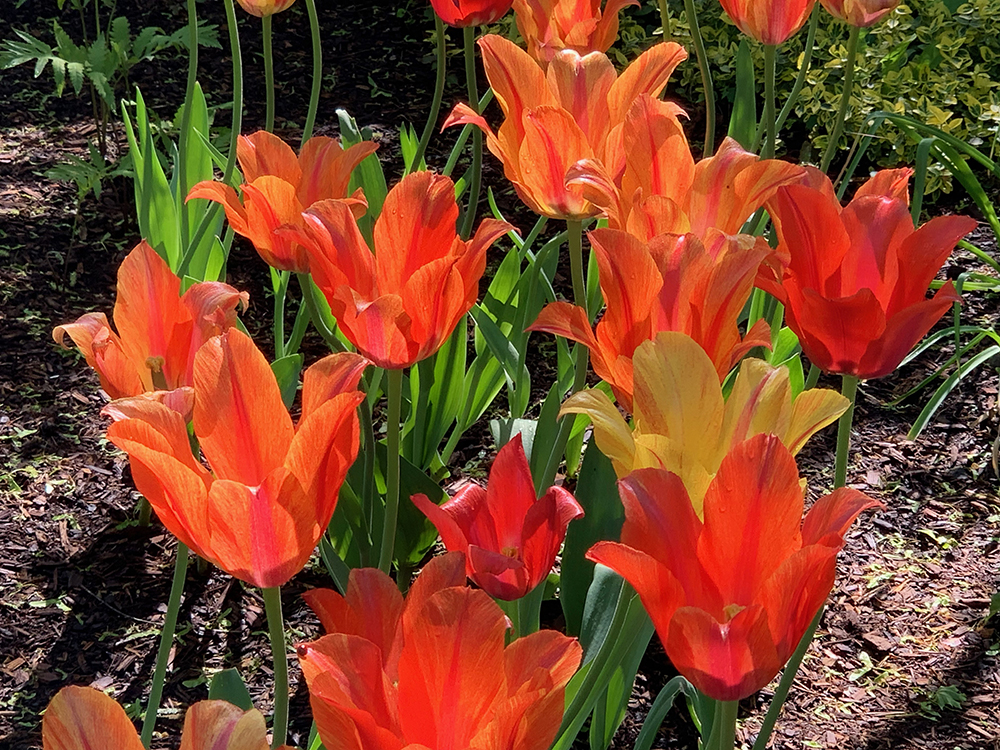
On a very chilly day last November, I planted tulips for the spring. I planted 250 bulbs in fact, with the help of an electric gardeb auger. The day was chosen in the hopes that the major gorge of squirrels on acorns was past and that these bushy-tailed rats with good PR would be thinking of long winter naps. Still I sprinkled crystalized and very smelly coyote urine wherever I planted.
And now I am rewarded! Planting flowers is like planting trees, an assertion of faith that things will get better, that the sun will rise, and warmer days come again!
This season has been a great one for tulips! I was in the garden early yesterday morning, and the sun was shining brilliantly through them, irradiating the world with color. Hence the simple image of Figure 1. I wanted to share it with everyone, in the belief that better days will dawn – but not without our commitment to making them better, to planting flowers, both real and metaphorical.
Robert Mitchum
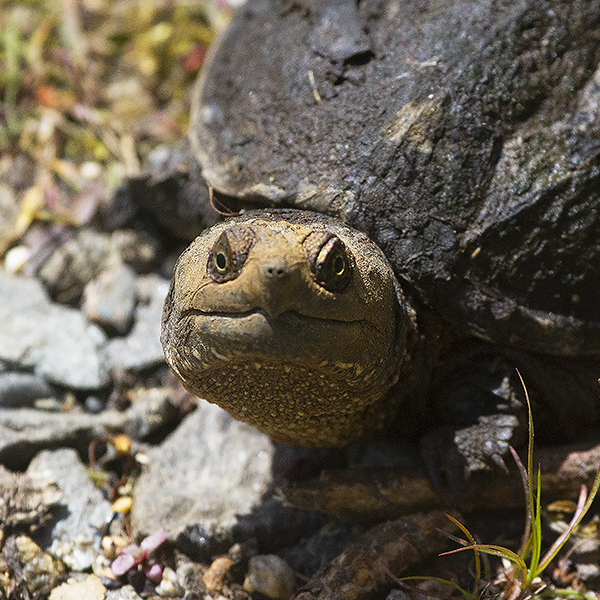
Yesterday was an absolutely glorious day and I went for a walk with my camera at Great Meadows National Wildlife Refuge, in Concord, MA. At one point the trail has a little boardwalk bridge that crosses a now almost completely dry stream. As I approached this stream I could see a very spiny snapping turtle, only about five inches long, walking in the stream bed. I approached it cautiously so as not to panic it and even sat down and talked to it as I took photographs with both my iPone and my Canon.
It is a juvenile common snapping turtle (Chelydra serpentina). I emphasize the word juvenile, because for a while I was confused by its prehistoric spikiness and thought it was an alligator snapping turtle, which are not found this far north. An interesting feature is how the nostrils are at the very apex of the nose enabling this turtle to lie quietly just below the surface in its hunt for prey.
Snapping turtles cannot retract their bodies into their shells, known as carpaces. So this turtle just stared, probably unhappily at me. At one point it stretched out its neck and looked side to side revealing the origin of species name serpentina. For me, it was a metaphysical commune with nature moment.
I carefully got up and walked away. When I was a bit further down the trail, I turned and looked back. He had resumed his walk, as if nothing had happened. Resumed his focus and purpose.
My friend points out that he.she looks very much like the leading man, Robert Mitchum.
Canon T2i with EF 100-400 mm F/4.5-5.6 L IS USM lens at 375 mm, ISO 1600 Aperture Priority AE mode 1/4000th sec at f/7.1 with no exposure compensation.
The pink waterlily
There is something wonderful and calming about the gentle waterlily, the Nymphaeaceae that immediately invoke the calmness of a warm summer’s day and harken the naiads. These are the fresh water nymphs of ancient Greek mythology. The strange thing about these seminal myths is that they always raise, in me at least the desire that they were somehow true.
The pink waterlily (Nymphaea rubra) of Figure 1 I took by a quiet pool at the Fairchild Tropical Botanic Garden in Coral Gables, FL. Yes I was mindful of the Florida approbation not to get too close to the water’s edge.
Canon T2i with EF 100-400 mm F/4.5-5.6 L IS USM lens at 235 mm, ISO 1600 Aperture Priority AE mode 1/1000th sec at f/7.1 with no exposure compensation.
African Redhead Agamas
Figure 1 shows an African redhead agamas (Agama agama) that I photographed at the Viscaya in Miami, Florida. Also called the “rainbow lizard,” it is another beautiful but invasive species in Southern Florida. Originally from subsaharan Africa, it is spreading like wildfire in Florida’s hospitable environment,
Canon T2i with EF 100-400 mm F/4.5-5.6 L IS USM lens at 275 mm, ISO 800 Aperture Priority AE mode 1/200th sec at f/7.1 with no exposure compensation.

